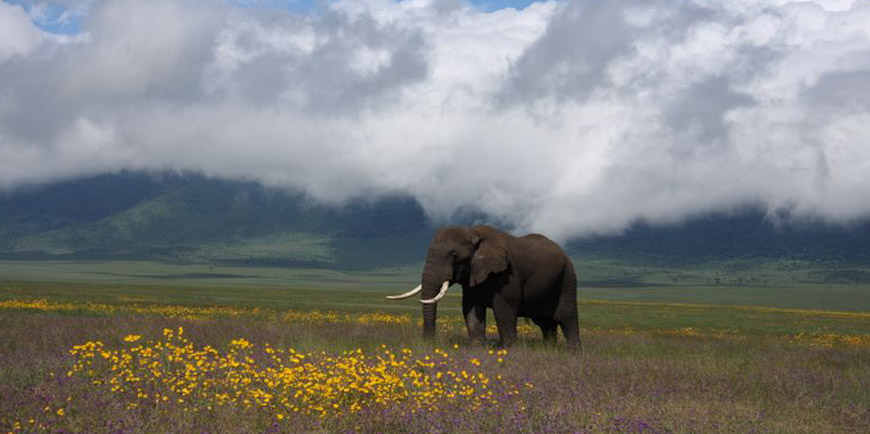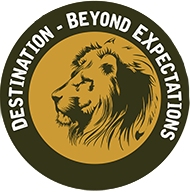
At 5,895 Kilimanjaro is the highest point in Africa. This volcanic massif stands in a splendid I solation above the surrounding plains, wuth its snowy peak looming over the savannah. The mountain is encircled by mountain forestand numerous wild mammals live in the park.
Outstanding Universal Value
Brief synthesis
Kilimanjaro National Park covering an area of some 75,575 ha protects the largest free standing volcanic mass in the world and the highest mountain in Africa, rising 4877m above surrounding plains to 5895m at its peak. With its snow-capped peak, the Kilimanjaro is a superlative natural phenomenon, standing in isolation above the surrounding plains overlooking the savannah.
Criterion vii: Mount Kilimanjaro is one of the largest volcanoes in the world. It has three main volcanic peaks, Kibo, Mawenzi, and Shira. With its snow-capped peak and glaciers, it is the highest mountain in Africa. The mountain has five main vegetation zones from the lowest to the highest point: Lower slopes, montane forest, heath and moorland, alpine desert and summit. The whole mountain including the montane forest belt is very rich in species, in particular mammals, many of them endangered species. For this combination of features but mostly its height, its physical form and snow cap and its isolation above the surrounding plains, Mount Kilimanjaro is considered an outstanding example of a superlative natural phenomenon.
Integrity
Kilimanjaro National Park, established in 1973, initially comprised the whole of the mountain above the tree line and six forest corridors stretching down through the montane forest belt. At the time of inscription in 1987, the main pressures affected mostly the forest reserve which acted as a buffer zone to the park. The World Heritage Committee recommended extending the national park to include more areas of montane forest. Following a 2005 extension, the National Park includes the whole of the mountain above the tree line as well as the natural forest (montane forest) which was under Kilimanjaro Forest Reserve, and as such fulfils the criteria of integrity. It is important that the extension of the National Park be reflected in the boundaries of the property.
The wildlife of the property is important to the experience of Kilimanjaro, although the property is not inscribed in relation to biodiversity criteria. Pressures on elephant, buffalo and antelope, and logging in the Forest Reserve area, were noted as integrity concerns at the time of inscription. The park is connected to Amboseli National Park, however corridors to Arusha National Park and Tsavo National park have been encroached, impacting on wildlife migration.
Protection and management requirements
Kilimanjaro National Park is protected under national legislation as a National Park and a management plan is in place. The property requires an effective and managing organization, including sufficient well equipped ranger presence to be able to carry out surveillance and implementation of the management plan. A key management issue is maintaining the aesthetic quality of the property as a spectacular natural site. Protecting its visual integrity and sustaining its natural integrity are key management issues. Key viewpoints to the property also need to be protected, including from Arusha and Amboseli where the most famous views of the property can be seen. An effective programme of research and monitoring of the property is also required.
Threats to the property include increasing and cumulative stress from sources such as adjacent land uses, downstream effects of air and water pollution, invasive species, fire and climate change. The glaciers of the property are vulnerable to retreat, and are cited as a feature of particular vulnerability to global climate change. The impacts from these threats need to be closely monitored and minimized. Tourism poses a significant threat and careful planning of related infrastructure and access development is required. Human pressure on the property needs to be managed, which can result otherwise in illegal harvest of its resources, encroachments to park boundary and blockage of migratory routes and dispersal areas. Education programmes and integration of park management with all involved partners and stakeholders, including the surrounding rural population, is essential.
CLIMBING ROUTES
Machame Route
- Nicknamed the “Whiskey” route because the route is popularized as somewhat difficult and more expensive than Marangu route. On an overall comparison of the routes to scale Kilimanjaro, this is one of the best routes to take, both in terms of acclimatization and cost. In certain sections this route is steeper than the Marangu and Rongai routes and physically more demanding but is easier overall.
- Highly recommended for scenic value
- Great for acclimatization with lots of walk high, sleep low opportunities
- Challenging trek with stunning scenery through 5 diverse climatic zones
- Good opportunity to split pre-summit day climb to leave climbers rested before summiting
- Very popular trail
- Fully catered camping only
- It takes 6–7 days for climbing.
Marangu Route
- Nicknamed the “Coca-Cola” route because the route is popularized as easy and cheap. This, however, is a misconception as the route is more difficult due to the ‘not as good acclimatization profile’ as Machame/Rongai/Lemosho routes.
- Often selected by unprepared, inexperienced climbers because of its reputation for being the “easiest” route, attributing to the lower success rate
- The shortest and cheapest route, but less time to acclimatize, therefore lower success rate
- Dormitory style accommodation in huts
- Less scenic due to ascent and descent on same route
Shira / Lemosho Route
- High summit success rate. Good for acclimatization, especially on the longer itineraries
- Remote and spectacular, dramatic gorges and views of west Kilimanjaro
- Converges with Machame on day 4 at Baranco
- Shira offers higher start point compared to Lemosho and poorer acclimatisation
- Fully catered camping only
The Lemosho route approaches Kilimanjaro from the west. Rather than simply intersecting Shira Plateau (like Machame), Lemosho crosses it from Shira Ridge to Shira 2 Camp, in a pleasant hike. Climbers encounter low traffic until the route joins the Machame route. Afterwards, Lemosho follows the same route through Lava Tower, Barranco and Barafu, known as the southern circuit. There are several options to complete the trek over 7, 8, or 9 days based on your experience.
Rongai Route
- Only northern approach to Kilimanjaro
- Offers a true wilderness experience on the early stages of the climb
- Very tough final summit night from the north
- Fewer acclimatisation opportunities
- Less scenic and flat than other routes
Also known as the Nalemuru route. Although the scenery is not as varied as the western routes, Rongai makes up for this by passing through true wilderness areas for days before joining the Marangu route at Kibo camp. Rongai is a moderately difficult route, and is highly recommended, especially for those with less backpacking experience. There are different options to complete the climb in 5, 6, or 7 days.
Umbwe Route
- Steep, short route with lower success rate
- Poor acclimatization because of rapid ascent
- Very remote and quiet
- Fully catered camping only
Of all the routes, Umbwe is by far the most scenic albeit steeper route up the mountain. The Rongai is the easiest camping route and the Marangu is also easy, but accommodation is in huts. As a result, this route tends to be very busy and ascent and descent routes are the same. Although the Rongai route is a flatter walk, it offers fewer opportunities for acclimatization. The Machame and Lemosho routes both allow better opportunities to “walk high and sleep low”, which is critical to avoiding altitude sickness.
Northern Circuit
- Longest route up Kilimanjaro – good for acclimatization
- Only route to traverse all of the Northern Slopes on a circumnavigation of the mountain
- Beautiful scenery from the western approach
- Fully catered camping only
The Northern Circuit is the newest route up Kilimanjaro and also the longest. The Northern Circuit takes a minimum of 8 days to complete but most operators offer the 9 day option. Because of its length, the Northern Circuit has the highest summit success rate. The route follows the same as the Lemosho Route for the first two days and then veers off to circle around the quieter northern slopes to the east side of the mountain. There a number of route variations, but generally the Northern Circuit approaches the summit via Gilman’s Point before descending on the same route as the Machame and Lemosho.

